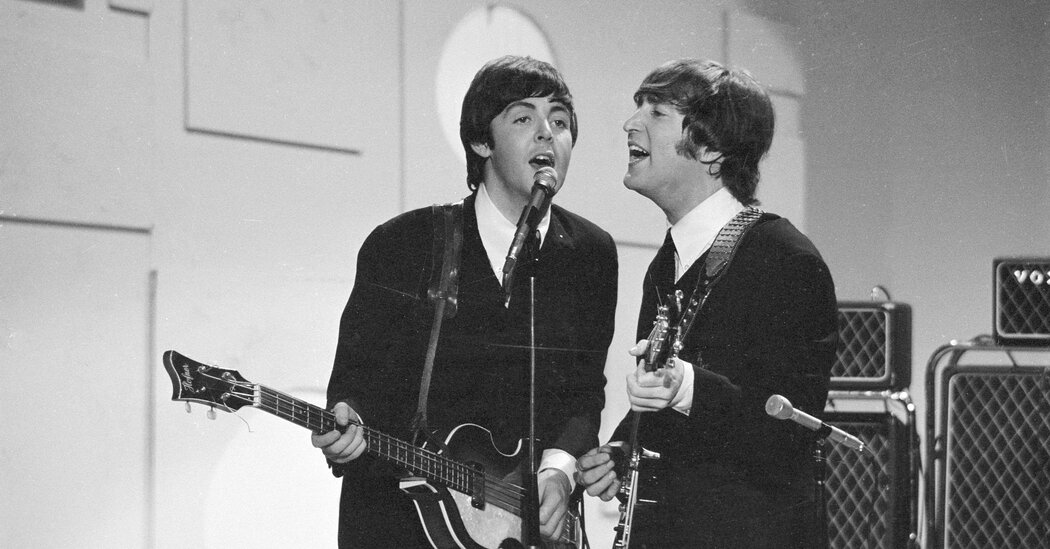JOHN & PAUL: A Love Story in Songs, by Ian Leslie
In our culture, music is most often written about in terms of sales, streams and chart positions. That is, of course, the least intelligent way to think about or talk about music.
Ian Leslie’s “John & Paul: A Love Story in Songs” is unconcerned with all that, but rather it explores the way two extraordinarily gifted young men combined and exchanged their gifts while inspiring, challenging, teaching and learning from each other.
In the great teams of composers before John Lennon and Paul McCartney — Rodgers and Hart, Lerner and Loewe, Leiber and Stoller, Bacharach and David — one of the members wrote the music and the other wrote the lyrics. John and Paul both wrote music and both wrote lyrics, and they made a decision at the beginning of their collaboration to share the credit on all of their compositions, thereby creating a third being called Lennon and McCartney. That selfless, generous merger, as their egos shape-shifted into and out of each other, unleashed a power that took music to a height that has not since been surpassed, or I think it safe to say, even reached.
I fell in love with rock ’n’ roll music when I was 9 years old in 1957 and first heard “Whole Lotta Shakin’ Goin’ On,” by Jerry Lee Lewis. I clearly remember rolling around on the floor laughing at the explosion of freedom and joy in that recording, and in that moment I thought that that was how I wanted to spend my life. By 1960, however, the rock ’n’ roll explosion had faded away. Buddy Holly was killed in a plane crash. Elvis Presley was in the Army. Chuck Berry was in jail. Eddie Cochran died in a car wreck. Little Richard was in the ministry. Jerry Lee Lewis had been canceled. Rock ’n’ roll seemed at a dead end.
Three years later, however, these two young musicians and their friends George Harrison and Ringo Starr, all from a seaport in the north of England, reinvented a style of music that had come from the backwaters of the Mississippi Delta, the highlands of the Appalachian Mountains and the mean streets of our cities. In the next five years, while absorbing and combining the art and music of the rest of the 20th century, they made music that took us all on an exquisite trip into other worlds of sound and meaning in a feat of invention that seems and is, I think, superhuman.
Though there has probably never been music that has permeated and elevated mass culture to a higher degree, this book is not interested in music as a mass commodity. This book is about soul, about grief and most of all about love — the love that two boys who lost their mothers far too soon have for each other, the courageous way they merge and the unfathomable power of that merger.
Leslie, a British journalist and author, has a deep affection for, and a penetrating understanding of, these complex characters and their unprecedented friendship — from their boyhoods in Liverpool, through the debauchery of postwar-Hamburg night life, through their lightning rise to international fame, through the remarkable string of albums with the explosive innocence of “With the Beatles” in 1963, the jubilant rockabilly of “Beatles for Sale” in 1964, the cannabis-fueled “Rubber Soul” in 1965, the epic psychedelia of “Revolver” in 1966 and “Sgt. Pepper’s Lonely Hearts Club Band” in 1967 — which, perhaps inevitably, ended in acrimony not long thereafter. Having lived through that period of time myself, it is stunning to follow Leslie’s insights into how far and fast John and Paul traveled, how profound their preternatural alliance was, and how epic their heroic journey.
I’m sorry John isn’t here to read this book. I hope if Paul does read it he feels the depth of appreciation and gratitude and intelligence it contains. There is a passage about them being high on LSD, after recording the song “Getting Better” during the “Sgt. Pepper’s” sessions, that seems to me central to Leslie’s understanding of his subjects:
That night, John and Paul did something that the two of them practiced quite a few times during this period: They gazed intensely into each other’s eyes. They liked to put their faces close together and stare, unblinking, until they felt themselves dissolving into each other, almost obliterating any sense of themselves as distinct individuals. “There’s something disturbing about it,” recalled McCartney, much later, in his understated way. “You ask yourself, ‘How do you come back from it? How do you then lead a normal life after that?’ And the answer is, you don’t.”
One plus one equals two unless you are counting, say, drops of water, in which case one plus one can equal one, or it can equal a fine mist. In “John & Paul: A Love Story in Songs,” one plus one equals eternity.
JOHN & PAUL: A Love Story in Songs | By Ian Leslie | Celadon | 436 pp. | $32
